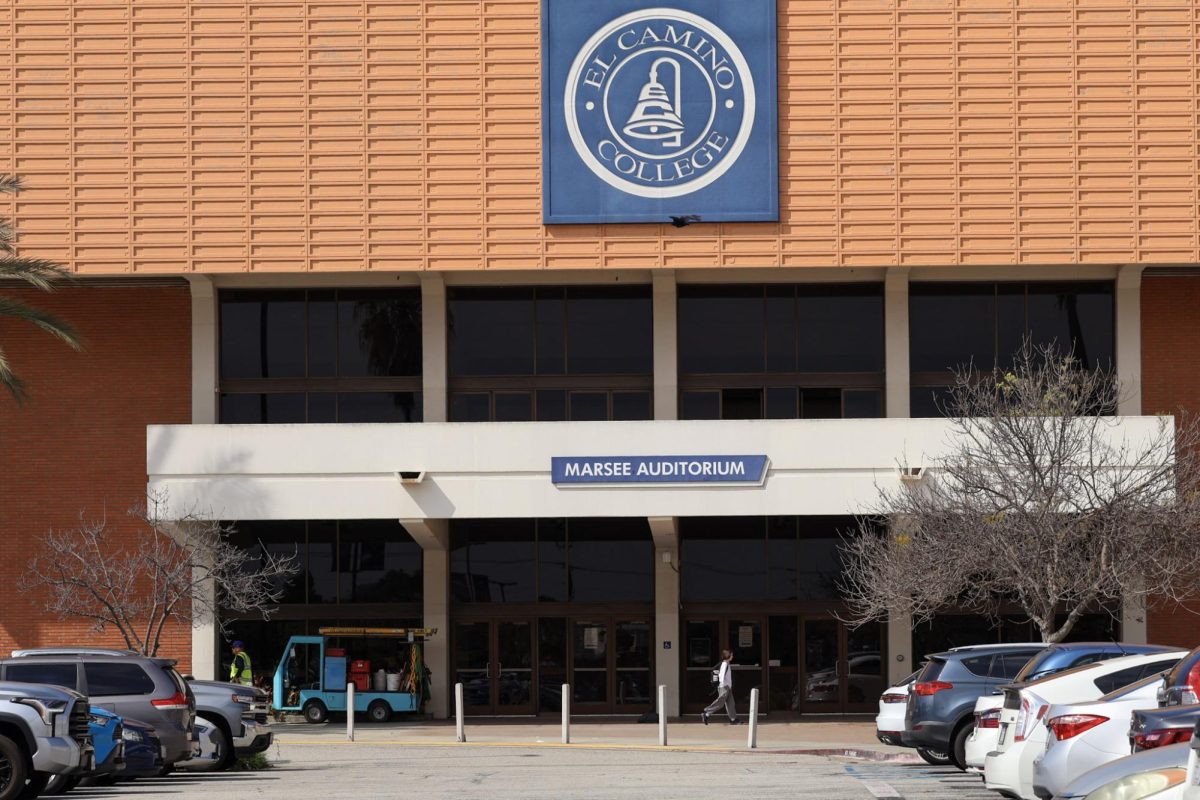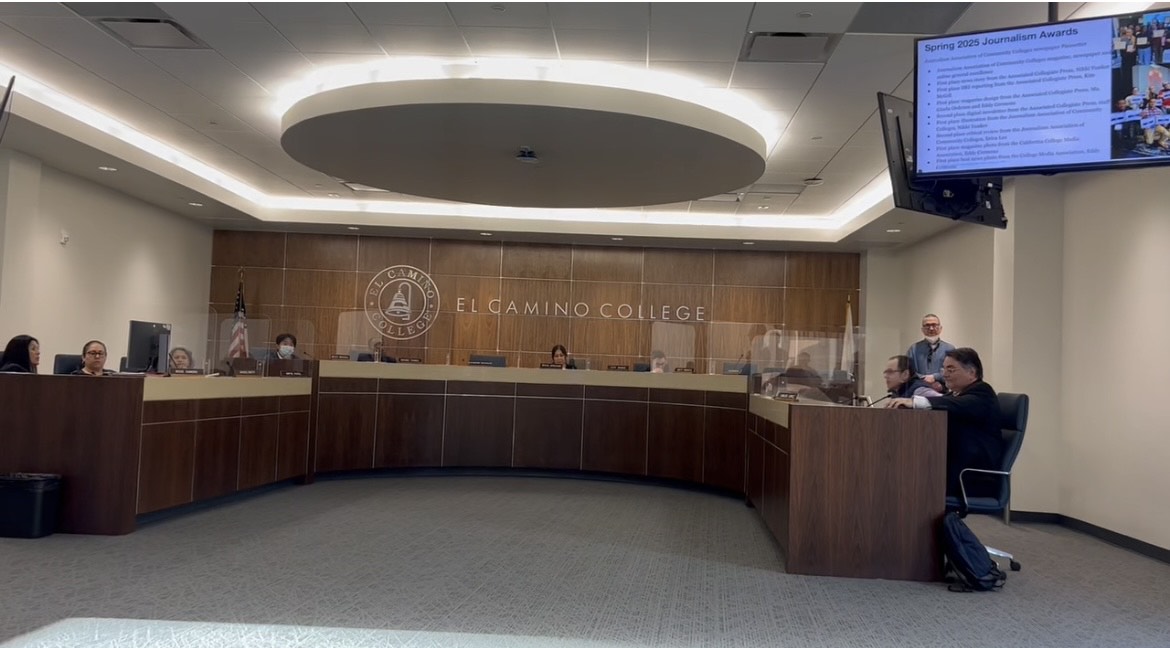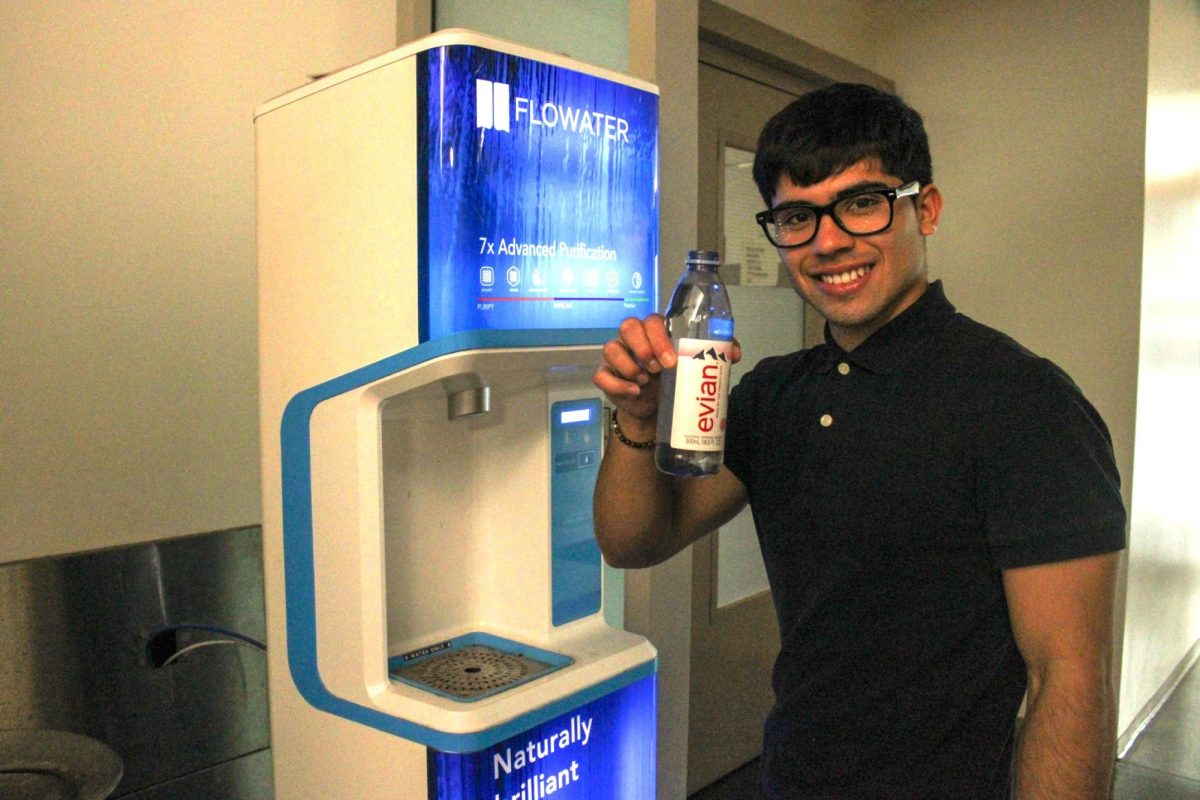Nearly 50 years ago, James Marks was sitting on the couch of his family’s home in Long Beach’s Carmelitos Housing Projects watching Saturday morning cartoons.
In an explosion of noise and confusion, five people burst through the front door.
One of them shouted, “Where that b—ch at?”
Without waiting for an answer, they tore through the apartment, making their way upstairs to where Marks’ aunt was sleeping.
Marks jumped up – a kid in pajamas and bare feet – and ran to the bottom of the stairs to intervene.
A guy with a gun said, “Nah, sit back down little man.”
He returned to the couch and hugged up on his sister and baby cousin.
“When I get older no one will ever be able to do us like this,” he said to them.
The day after drug dealers stormed into the house and beat his aunt over an unpaid debt, Marks said he left his childhood behind and looked for power and opportunities on the streets.
“I was a kid running around the projects with a cardboard box, breakdancing. But, the next day I started hanging out on the corner with the older guys who were drinking Silver Satan and Thunderbird and Old English,” he said.
The War on Drugs – and the chaos, addiction, incarceration and death it fueled – had a devastating impact on Marks, his family and Black and Brown communities across the US.

In 2016, California voters passed Proposition 64 – the Adult Use of Marijuana Act – with a wide margin, 57% in favor over 43% opposed.
But, Marks and other residents say that the promises made to voters, especially to communities that were most severely impacted by drug criminalization, have been broken.
History and impact of the War on Drugs
Like many Black families, Marks’ mother and aunts left the southeastern United States and followed his grandmother to Southern California in search of safety and economic opportunity.
“We had a tight-knit family,” Marks said, describing cookouts at the park and family birthday parties.
He attributes vices to affecting his life.
“Then, drugs changed the whole trajectory of my life. We saw very beautiful, well-mannered people degrade themselves and start exchanging sex for drugs up and down these streets.”
Marks watched the progression of his aunt’s addiction. “She would go out on drug sprees for days,” he said.
Marks’ mother struggled to pay his aunt’s debts while also maintaining all the other expenses. Marks and his sister – only children themselves – were suddenly responsible for caring for their younger cousins, including cooking and cleaning.
“It took our childhood away from us,” he said.
Marks started committing robberies and by the age of 12 he was locked up.
He spent his teen years in juvenile halls, probation camps and California Youth Authority on drug and other charges. Eventually Marks went to state prison.
Overall, he spent eleven years of his life incarcerated.
The War on Drugs was built in Los Angeles and exported throughout the US and world.
Local law enforcement used drug suppression to neutralize the Black and Brown power movements, including establishing the use of militarized policing during the ‘65 Watts Rebellion, and creating the nation’s first SWAT unit, initially tested in an LAPD assault on the Black Panther offices on Central Avenue.
Richard Nixon rose to political power in LA County, and eventually instituted the War on Drugs and zero tolerance policies to dismantle social justice organizations.
US President Ronald Reagan also rose to political power in LA County, and as both Governor of California and President, his policies included taking zero tolerance into schools resulting in a vicious school-to-jail track; globalization, deregulation and international outsourcing of hundreds of thousands of living wage manufacturing jobs; and support for LA’s Howard Jarvis and the anti-tax movement leading to the passing of Proposition 13 in 1978 that quickly bankrupted California’s social service net.
As President Reagan’s War on Drugs raged on – with harsher sentencing laws and greater investment in police, courts and incarceration – his administration, in cooperation with local law enforcement, simultaneously flooded poor and working class Black and Brown communities with drugs and guns, and recycled the profits into a clandestine war against the liberation movements in Central America (Iran-Contra).
Congressional hearings and federal investigations have revealed that in LA County, these policies had the combined effect of replacing unionized manufacturing with the deadly and addictive drug economy.
Marks described the drug hierarchy in Long Beach.
The guys in the projects got their drugs from a contact in Compton who were connected to Watts who got their supply from Freeway Rick Ross who got drugs through the Columbians by way of Iran Contra all in collaboration with the Reagan administration and local law enforcement.
“We had train tracks right next to the projects. We would find semi-automatic weapons inside train cars left on the tracks. There would be crates and cases of AK-47s and Uzis.”
Jaime Gregory, 49, works for Volunteers of America in South Central LA to prevent school and community violence. He described a similar system for distribution further north in Watts.
“The government supplied the guns and drugs,” Gregory said. “One time, a caboose was sitting on the train tracks by itself, wide open. We went in there and opened up crates of guns. I was 11-years-old.”
Gregory dealt weed through high school in order to pay for his clothes, school supplies and the bucket he relied on for transportation – a used car that always broke down.
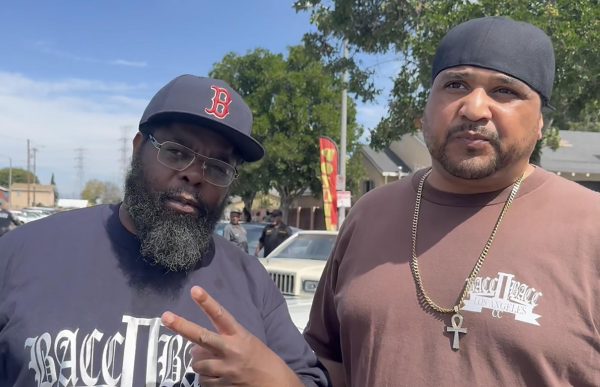
He later completed El Camino College courses while he was incarcerated on drug charges at Terminal Island.
“With our parents struggling to keep a roof over our heads and the welfare system not providing the help that they should, kids were learning the drug trade and feeling that was the way out,” Gregory said.
While the underground drug economy was built by local and federal law enforcement and government officials, Black and Brown communities were blamed and punished.
The policies and politicians that came out of LA sparked the largest prison expansion in U.S. history. Between 1982 and 2000, the California prison population grew by 500%, and between 1984 and 2005, California built 21 state prisons, but only three universities.
By 2007, California’s prison system was the largest in the world with 171,444 people incarcerated.
Nationwide, there are now more Black people locked up in the US than were enslaved in the years leading up to the Civil War.
After fifty years experiencing the exorbitant costs and failed outcomes of drug enforcement, Californians who passed Proposition 64 were seeking a new way forward.
Marijuana arrests in California dropped from a high of more than 200,000 in 1973 to less than 5,000 in 2019.
The hope was that legalizing marijuana would also provide communities most impacted by the War on Drugs opportunities to prosper in the new “legal” cannabis industry.
In-Equity
Now 56, Marks has been organizing over the past several years for justice and true equity in the implementation of cannabis legalization.
“We were targeted. We are owed opportunity, access, equity. We’re owed some of these dispensaries.” Marks said.
He said that out of 38 cannabis licenses in Long Beach, only one is Black-owned.
“You’re selling drugs in our own community and we can’t sell drugs? And I got people that are still incarcerated behind this,” Marks said. “Their families are devastated and impacted forever.”
As of January 2024, California had 866 licensed dispensaries and 374 licensed marijuana delivery businesses.
It’s difficult to determine how many dispensaries are truly owned and operated by community members directly impacted by marijuana prohibition.
One significant challenge is that California does not set a statewide definition of social equity eligibility.
The 2018 “California Cannabis Equity Act” authorized the state Department of Cannabis Control (DCC) to provide funding and technical assistance to local equity programs. But, local jurisdictions are left to establish their own equity programs and to select equity businesses.
Applicants apply for licensing through local cities or counties and also have to apply to the DCC.
But, Equity grants are provided to local jurisdictions through The Governor’s Office of Business and Economic Development (GO-Biz).
Asked if it would be more efficient if equity programs were also operated through DCC, one state official said, “Answering that question could get me fired.”
Miriel “Mae” Bereal, 42, has been a leader in establishing both LA’s and Long Beach’s equity programs.
Born in Long Beach, she was raised in the Springdale projects on the city’s west side. The child of an immigrant mom from the Philippines and an African American father, Bereal felt like she didn’t fit in anywhere.
“I grew up around gang violence. I literally was caught in the middle of shootouts,” Bereal said.
She started smoking weed as a way to cope with stress and trauma.
“I had a lot of troubles, and instead of taking antidepressants or antianxiety meds I had cannabis. That’s what I was around, nickel bags, dime bags, stress or chronic. That’s all I knew.”
As she got older, she got interested in the medicinal use of cannabis and, eventually, the whole industry.
Bereal explained that several factors make it nearly impossible for Black and Brown people – especially those most impacted by the War on Drugs – to open a licensed cannabis business.
First, people have to determine if the jurisdiction they are located in even allows cannabis businesses to operate.
LA County currently prohibits all commercial cannabis business activity – cultivation, manufacturing, delivery and sales – in unincorporated areas, forcing business owners, customers and workers to negotiate with local cities, each of which has their own regulations and licensing processes.
Some cities – but not all – eliminate licensing fees for equity applicants and might offer additional funding.
Bereal’s licensed cannabis business, LAV8 – (pronounced Elevate) – is opening in Long Beach. She has gotten about $300,000 in equity grants, and has invested an additional $80,000 of her own money.
In addition to licensing costs, businesses need to secure capital for rent, the build out and furnishing of a space, equipment, labor and product – all before selling a single gummy, brownie or blunt.
To start the licensing process, applicants also have to retain a physical space for their business. For the past two years, Bereal has paid rent on a commercial space that she is required to have, but can’t operate.
She has her state license, but can’t open until the city licensing process is complete.
“A lot of people get stuck at the starting line of the equity process and never actually begin,” Bereal said.
Because of the high start-up costs, many local jurisdictions push equity applicants to look for investors.
With fierce competition for the small number of licenses available – along with the application and financial benefits that come with equity programs – some investors and cannabis companies look for Black and Brown people impacted by the War on Drugs to front their operation.
“I would call them puppets,” Bereal said.
She said she never expected to get abused by industry players.
Bereal first went through the licensing process in LA.
She said all of the money she put into the business, her brand and the license she obtained were stolen by investors who were only using her as the “face” needed to participate in LA’s equity program.
“I went to a lot of LA City Council meetings to let them know, ‘You are all literally setting us up to fail.’ And I was among the people who lost everything – cars, a house – trying to hold on to these buildings and opportunities that they promised would be ours.”
In LA, only 11 out of 105 social equity licenses issued by the Los Angeles Department of Cannabis Regulation are operating businesses, and of these, only 4 are women-owned.
According to MJBiz Daily, nationally, 85% of cannabis ownership is white.
“Equity isn’t receiving its 40 acres and a mule,” Bereal said. “The wealthy white person is. The Russian and Chinese investors are.”
Marks was first told by his city councilmember that the plan for cannabis equity in Long Beach was to hire 51% of the community and process applications for expungements [of criminal records].
“That’s not equity,” Marks said to the official. “That’s slavery. Equity is ownership.”
Dangerous results
Legalization was promoted as a way to reduce street violence and improve worker safety and opportunities.
But, workers in both licensed and unlicensed shops report that conditions remain exploitative and dangerous.
When 21-year-old El Camino college student Juan Hernandez was laid off at the start of the pandemic, the whole economy was shut down. Dispensaries were one of the few industries that remained open.
He found a job at VIP Collective, an unlicensed dispensary sandwiched between two other unlicensed shops on S. Western Avenue in Los Angeles.
A few months after starting at VIP, Hernandez disappeared. On Nov. 15, 2020, his body was found in a remote section of the Mojave Desert.
On February 26, 2024 VIP’s owner Weijia Peng, 34, and the dispensary’s manager Ethan Astaphan, 30, were found guilty of his murder.
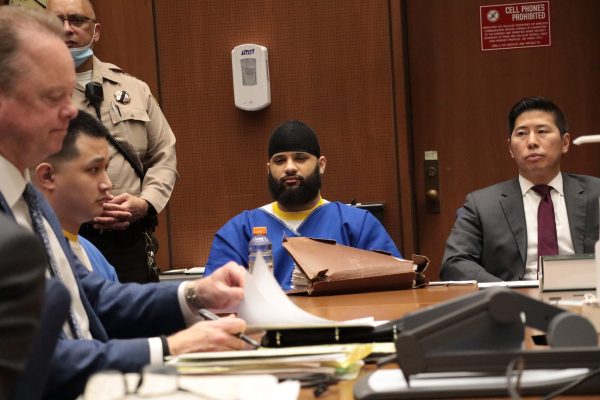
The trial revealed much about conditions for workers in the underground cannabis economy.
Photos and testimony showed a shop that was disorganized and filthy.
Jailen Commissiong testified that when he was 19, he worked as VIP’s security guard six – sometimes seven – days a week from 9 a.m. – 10 p.m. He had no guard card and had never been trained as a security guard. He wore no uniform.
In the days leading up to Hernandez’s murder, Astaphan messaged Peng in WhatsApp, “LA is horrible. This business is toxic, but an eye opener. I see how it turns you into a paranoid, hateful person.”
Marks worked for one of the largest cannabis companies in Southern California that generated $3,000 – $5,000 a day; $10,000 – $20,000 on a day promoting a sale.
He called work conditions “horrific” inside the dispensaries.
“You have guys taking advantage of younger females. Having people work from sun-up to pass out, 16, 18, 19 hours. No benefits. Getting minimum wage. There’s no security. People’s lives are on the line every second, verbal threats, people come in to rob it. A security guard in Watts was killed,” Marks said.
“It’s like a straight trap house, even the licensed ones,” he added.
Three years ago Marci Ramos, 34, submitted her resume to an online job search site.
Ironically on Apr. 20, she was hired by a large cannabis company that owns thirty licensed dispensaries, warehouses that house large indoor growing operations, and manufacturing and distribution of cannabis products – including blunts, vapes, wax and edibles – as well as paraphernalia and merchandise throughout California.
“I didn’t know what it was until I got there,” Ramos said. “I didn’t get an interview. There was no orientation.”
She started at $17 an hour as an administrative assistant.
Now she works in billing, tracking income owed, and handling disbursements.
She is responsible for tasks she said her manager – who earns $90,000 a year – can’t do, but after three years she only earns $20 an hour, the same as an entry level fast food worker.
The owner is Asian and has a Russian partner. In the entire company she knows of only one Black and one Latino manager. All other managers are white or Asian. The lowest paid workers – the cutters in the grow operation – are nearly all Latina women.
Ramos also described a culture of sexual harassment.
One young woman worked in the distribution warehouse with a team of men. When she complained about repeated abuse, Ramos said there was no real accountability.
“Management doesn’t really interfere unless it’s a worker they care about,” she said.
The employee quit.
Ramos also said that managers and employees get no training on sexual harassment.
“A manager had a new employee that she favored the most. The manager would come to that girl’s desk and have the girl sit on her lap,” Ramos said.
She said that not long after that began, that new staff person’s hourly wage was raised from $20 to $27.
Ramos said she wished she could move up in the business.
“That’s something that I really thought about. But I can’t pour myself into something that doesn’t value me.”
Lack of access and lost revenue
Proposition 64 legalized the use and sale of recreational cannabis in California for adults 21 and over, including large-scale cultivation for a new, licensed marketplace as well as home growing of up to six plants for personal use.
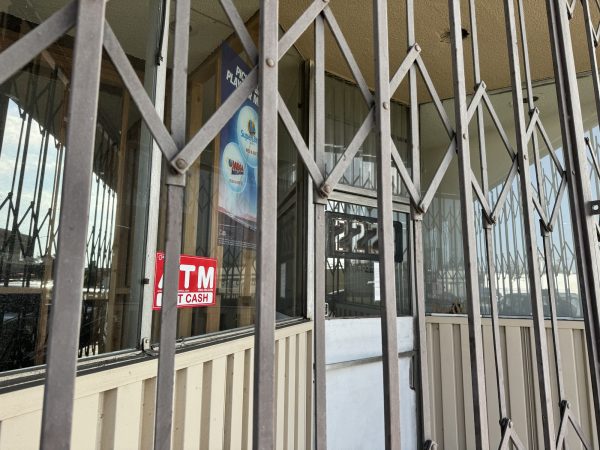
The law built on values long-held by most Californians that medical and recreational use of marijuana be both decriminalized and legalized.
This included voters’ passing of Proposition 47 – the Safe Neighborhoods and Schools Act – in 2014 that reduced penalties for many drug and related convictions, reducing the use of harsh jail and prison sentences in favor of treatment and community-based opportunities, as well as the Compassionate Use Act that Californians passed in 1996, establishing the state as the first to allow medicinal cannabis use.
But despite a clear mandate from their constituents, all but two South Bay cities are prohibiting cannabis sales for recreational use – and in most cases – even medical marijuana sales and home growing for personal use.
Blocking access to cannabis, along with high prices and taxes, contributes to the continuation of unlicensed shops, home deliveries and street dealing.
A state DCC official described a raid of an unlicensed shop.
As he was standing outside with several armed investigators about to serve a warrant, a customer rode up on a bicycle. He asked if he could go inside and buy before the raid.
“I looked for the closest legal shop on my phone and gave him an address. But it was two or three miles away. I doubt he would have gone that far on a bike,” the state official said.
“We close shops down and they pop back up in a few months,” he added.
The lack of access to licensed dispensaries also means that both local communities and the state are losing jobs.
Vangst, a job platform that tracks industry employment and connects cannabis companies to potential workers, reported in its 2024 jobs report that California has only reached 83,000 cannabis jobs out of a potential of 133,000.
In addition, cities, counties and the state are losing significant tax revenue.
According to Marijuana Moment, a research and media organization covering the cannabis industry, “California is less than a $5 billion market today (and shrinking). The state has, by far, the lowest per capita sales of any mature cannabis market.”
If California’s licensed market was performing at a rate equal to Michigan’s or Montana’s, it would be generating $13 billion a year.





![Physics and astronomy professor Susan Stolovy presents astronomical news and updates to attendees at the first planetarium show of the semester at El Camino College on Friday, March 28. Prior to becoming a professor at ECC, Stolovy completed her doctorate in physics and worked as an astrophysicist for NASA and the California Institute of Technology on spacecraft missions. "[I'm] still very tuned into what's going on in the world of research as well, and I hope to bring a little bit of my experience into the classroom," Stolovy said. (Nikki Yunker | The Union)](https://eccunion.com/wp-content/uploads/2025/03/planetarium-Made-with-Clipchamp-3-frame-at-0m28s-1200x675.jpg)

